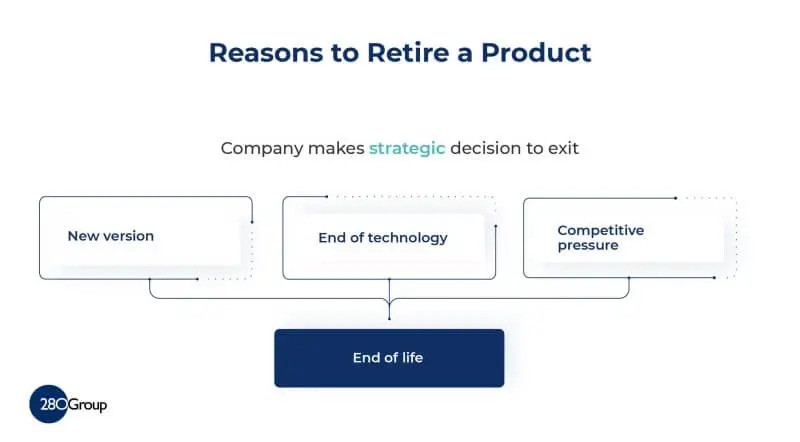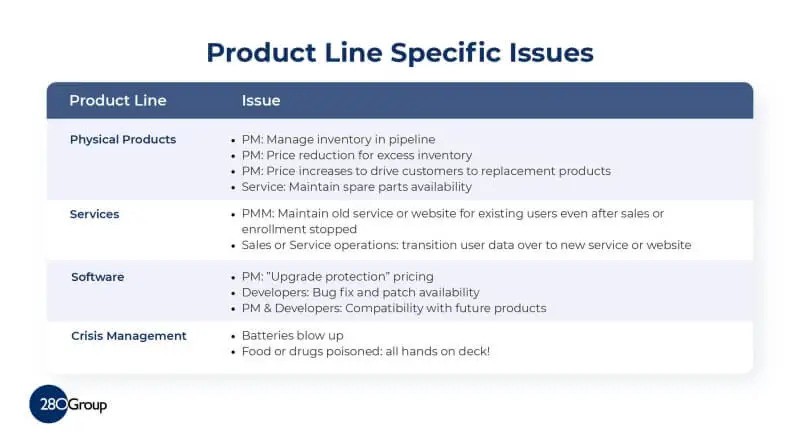
It’s a question we hear all the time… What is a Product End of Life (EOL) Plan? So we created this guide to help individuals, teams and companies answer that question.
Product End of Life (EOL), is when a product is retired from the market. Retirement can involve completely pulling the product from the market without replacing it or, in many cases, replacing it with a new version. Products may reach EOL for a variety of reasons, such as technology changes that make the product obsolete, competitive pressure that make the product no longer viable, or the product simply can’t meet the required revenue or profitability thresholds.
What is Product End of Life:
Retiring a product (often called a product end of life) occurs when a company decides to exit the market.
Retirement can involve completely pulling the product from the market without replacing it or, in many cases, replacing it with a new version. Products may be retired for a variety of reasons, such as technology changes that make the product obsolete, competitive pressure that make the product no longer viable, or the product simply can’t meet the required revenue or profitability thresholds.

Critical Factors in Creating a Product End of Life (EOL) Plan
When developing your product end of life plan, keep the following critical factors in mind.
- Loyalty: How will you maintain customer loyalty?
- Negative implications: Do you encounter any legal or contractual implications if you stop selling the product? Have you promised customers anything that you won’t be following through on?
- Financials: Is this product still profitable, or are you losing money on it? If it’s profitable, is it worth the opportunity cost of spending resources to keep it in the market, or would these resources be better spent on something newer that may have more growth and profit potential?
- Physical concerns: If it’s a physical product, what are the ramifications of discontinuing the product in terms of inventory, channel partners, returns, or customer replacement and support?
- Risks: Are there any other risks associated with discontinuing this product, such as alienating longtime customers or possibly creating a backlash on social media if customers are unhappy that you have discontinued the product?
EOL or End of Life refers to a product being retired. Retirement can involve completely pulling the product from the market without replacing it or, in many cases, replacing it with a new version. Products may reach EOL for a variety of reasons, such as technology changes that make the product obsolete, competitive pressure that make the product no longer viable, or the product simply can’t meet the required revenue or profitability thresholds.
What is EOL?
Different Products – Different End of life issues
Different types of product have different issues at the end of their life. Which one applies to your situation? Make sure that these issues form part of your end of life plan.

Checking Out Parts of a Product End of Life Template
This product end of life template has many sections. Because the retire phase offers many options, you may not actually need to fill each and every section. Choose the appropriate sections for your situation.
- Executive Summary
- Product description – Which product or product line is being discontinued
- Parties affected by retirement – Internal groups at the company, Resellers and channel partners, Customers
- Retirement alternatives – Sell off product to another company, Spin out product, Continue sale for limited time, Shut down product in near term
- Chosen alternative and reasoning – Sell off product to another company. The product no longer is a good strategic fit for where the company is headed.
- Announcement plan – Critical dates, Manufacturing plan, Spare parts supply plan, Upgrade assistance, Customer support options, Technical support plan, Compatibility, Recycling/disposition guidelines, Trade-in or upgrade Options
- Critical success factors for retirement of product
Following Best Practices When Retiring a Product
There are a number of best practices to be aware of and implement when deciding to retire one or more products:
- Consider creating a standardized product end of life process so you can minimize and more easily predict the impacts to different groups within your company and to resellers and customers.
- Communicate early and often so that stakeholders know what to expect when.
- Get the support and backing of all responsible groups and executives well beforehand so that things go smoothly.
- Plan for continued support, warranty servicing, and so on for a stated time period to meet your stated policies to customers.
Make the retirement phase of a product just as important as the launch phase. When you successfully retire a product by keeping to a plan, you keep internal groups and external customers updated and happy.


